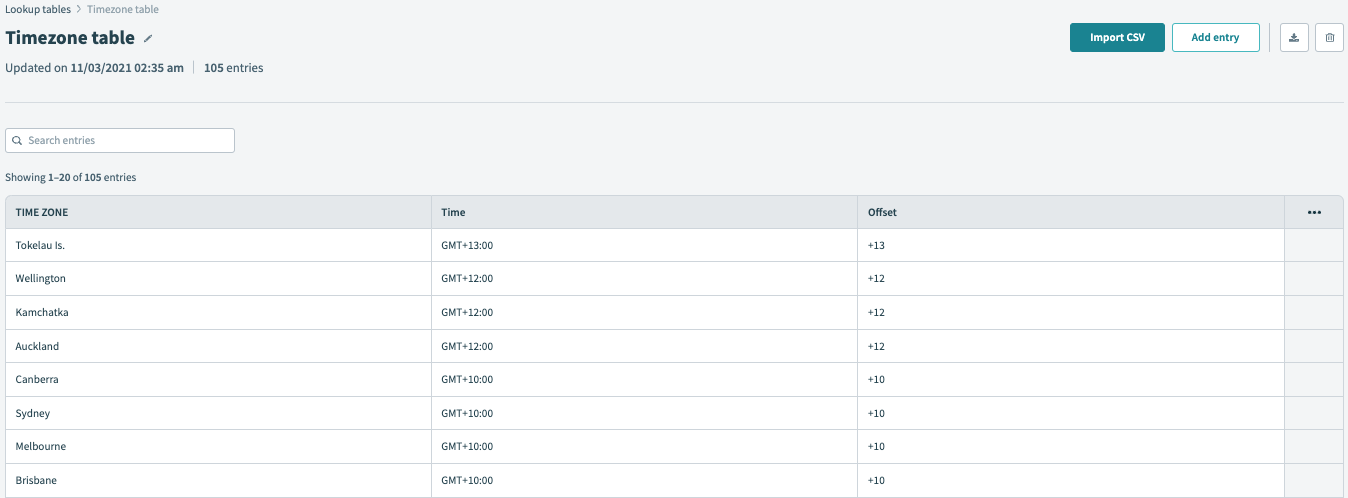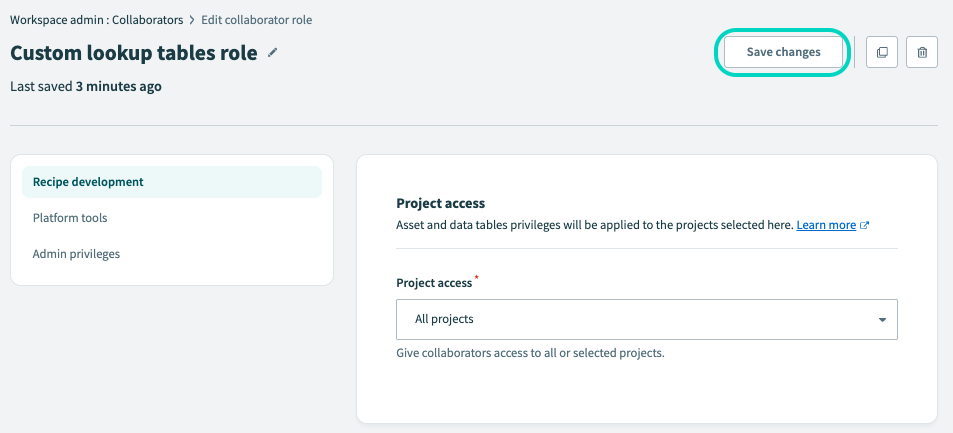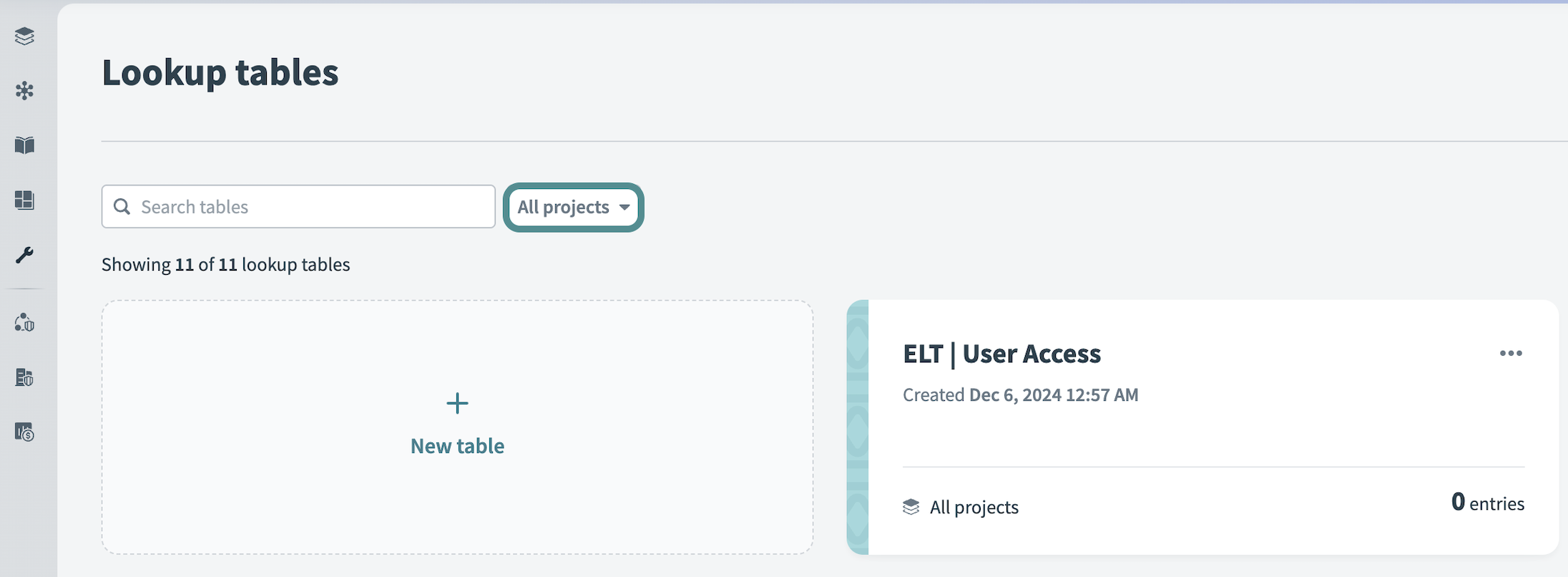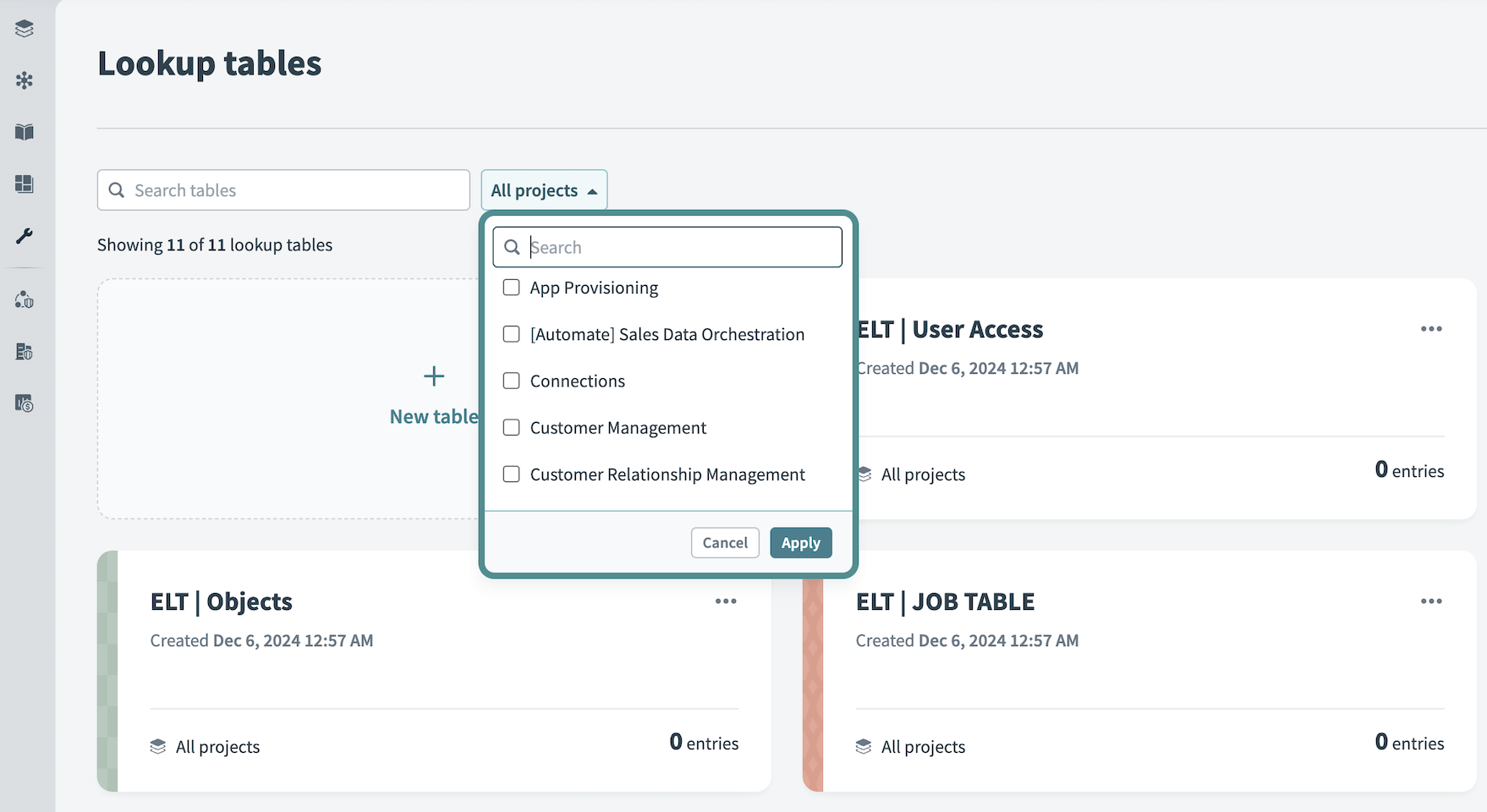# Lookup tables
Lookup tables enable recipes to efficiently store, reference, and manage frequently used data using a table of entry rows and value columns, similar to a cross-reference table.
The Lookup tables page enables you to manually create, delete, update, and parse tables.
The Lookup tables by Workato connector enables you to create recipes that add, update, delete, and retrieve information about entry rows, as well as delete tables.
FEATURE AVAILABILITY
The Lookup tables feature is available to customers on specific pricing plans. Refer to your pricing plan and contract to learn more.
You must have one of the following to access the Lookup tables page:
- The Lookup tables privilege.
- The Environment admin or Environment manager role.
- The legacy Admin or Analyst system role in workspaces using the legacy permissions model.
Collaborators without access to the Lookup tables page can still interact with Lookup tables through the Lookup tables by Workato connector if the recipe is within the table's scope.
 A Lookup table with timezones, times, and offsets
A Lookup table with timezones, times, and offsets
# Usage inspiration
WORKATO ACADEMY COURSE
For an interactive tutorial, see the Lookup tables (opens new window) unit in Workato Academy. Complete the entire course to receive the Automation Pro II certification.
The following are examples of lookup table use cases:
- Look up zip codes using city names.
- Convert metric measurements to imperial for a downstream app.
- Create a cache for transient information such as business processes.
- Store frequently used static data to reduce API
GETrequest costs. - Store frequently used static data from slow or non-performant
GETAPIs.
INCOMPATIBLE USE CASES
Lookup tables are not designed for the following use cases:
- Relational database solution: Lookup tables have enforced limits, so they do not work as long-term, large relational databases.
- Large data in a single cell: Do not store values larger than 10 kilobytes in a single lookup table cell.
# Lookup table limits
Lookup tables have the following limits:
| Description | Limit | Notes |
|---|---|---|
| Maximum number of lookup tables in a workspace | 100 | NA |
| Maximum number of columns in a lookup table | 10 | NA |
| Maximum number of rows in a lookup table | 100,000 |
|
| Maximum row size | 128 KB | NA |
| Maximum number of rows in a lookup table in Recipe lifecycle management imports and exports | 10,000 | NA |
| Maximum batch size in lookup table connector actions | 10,000 | This limit applies to the following connector actions:
|
# Control Lookup table access
Control access to your workspace's Lookup tables using the following methods:
- Modify collaborator roles
- Scope Lookup tables to specific projects
# Role-based access control for Lookup tables
You can use role-based access control to manage access to the Lookup tables page.
Complete the following steps to modify a collaborator role's Lookup table privileges:
Go to Workspace admin > Access control > Environment roles.
Select the role you plan to modify or click + Add environment role.
Go to Platform tools > Data storage.
In the Lookup tables row, select the privileges to assign the role.
 Lookup table privileges
Lookup table privileges
Click Save changes.
 Save changes to role
Save changes to role
SCOPE OF LOOKUP TABLE PRIVILEGES
Role-based access control only manages access to the Lookup tables page. Collaborators can still interact with Lookup tables that are scoped to projects they have access to through the Lookup tables by Workato connector.
# Assign Lookup tables to specific projects
By default, Lookup tables are accessible from all projects. You can limit the scope to make a Lookup table accessible only within a specific project. Once scoped, the table is visible only to collaborators with access to that project.
Complete the following steps to restrict a Lookup table to a specific project:
Go to Tools > Lookup tables.
Select the Lookup table you plan to scope.
Click Available in to open the Update availability dialog.
 Update the scope of a Lookup table
Update the scope of a Lookup table
Use the Choose a project drop-down menu to restrict the Lookup table's access to a specific project.
Click Update availability.
Use role-based project access to restrict which collaborators can access the project.
CHANGING SCOPE CAN AFFECT RUNNING RECIPES
Changing the scope of a Lookup table can affect its availability within currently running recipes.
HOW TO VIEW THE LOOKUP TABLES A USER CAN ACCESS USING THE CONNECTOR
Sign in to Workato as a user with the collaborator role you plan to check.
Open a project.
Create a new recipe. You can select Run on a schedule as your starting point.
Click + Add step and select Action in app.
Search for and select Lookup tables by Workato in the Choose an app search box.
Select any action.
Select the Lookup table drop-down menu to see which Lookup tables the user can access using the connector.
 Available Lookup tables
Available Lookup tables
# Set up your Lookup table
Complete the following steps to create a new Lookup table:
Go to Tools > Lookup tables.
Click + New table.
Click Edit (pencil icon) to enter a name for the Lookup table, and click ✓ Save to save your changes.
Click Import CSV to upload a CSV file with a header row that defines the column names and structure for the Lookup table, or click Add entries manually to add entries directly.
Click ✓ Save when finished.

# Add and update Lookup table data
You can add and edit Lookup table entries using the following methods:
# Import a CSV file
Complete the following steps to import a CSV file into a Lookup table:
Go to Tools > Lookup tables and click + New table.
Click Import CSV.
In the Specify action section, select one of the following options:
- Add row entries: Workato adds the CSV rows as new entries. Existing entries are not affected.
- Replace existing data: Workato overwrites existing entries with rows from the new CSV file.
 Import CSV window
Import CSV window
Drag and drop a CSV file into the Select CSV file field, or click upload from device and select a CSV file.
Select the Do not import the first row (header) checkbox if you don't plan to import the first row of the CSV.
Click Import CSV.
# Add or edit entries manually
# Use recipe actions
To automatically add and update entries, use the Add entry, Add entries, and Update entry recipe actions from the Lookup tables by Workato connector.
# Filter Lookup tables by project
Workato supports search filters to quickly find Lookup tables associated with different projects.
Complete the following steps to search Lookup tables using filters:
Navigate to Tools > Lookup tables.
Locate the project filter drop-down menu.
 Project filter drop-down menu
Project filter drop-down menu
Select the projects to filter Lookup tables by.
 Select projects to filter
Select projects to filter
Click Apply.
# Using the Lookup table connector
The Lookup tables by Workato connector allows you to interact with Lookup tables using the following recipe actions:
- Add entry
- Add entries
- Lookup entry
- Search entries
- Get all entries
- Update entry
- Delete entry
- Delete multiple entries
- Truncate table
# Add entry action
The Add entry action adds a new entry to an existing Lookup table.
# Input fields
| Field | Description |
|---|---|
| Lookup table | Select the Lookup table where you plan to create the entry. |
| Entry fields | This field includes a sub-field for each column in your Lookup table. Provide the contents of your new entry for each column. |
# Output
| Output | Description |
|---|---|
| Entry ID | The ID of the new entry. |
| Entry | This object contains a string for each column of the Lookup table specifying the contents of the new entry. |
# Add entries action (batch)
The Add entries action adds new entries to a Lookup table in batches.
# Input fields
| Field | Description |
|---|---|
| Lookup table | Select the Lookup table where you plan to create new entries. |
| Entries source list | Provide the list datapill that you plan to create entries from. |
| Entry fields | This field includes a sub-field for each column in your Lookup table. Specify the datapill from your list to use for each column in your new entry rows. |
# Output
| Output | Description |
|---|---|
| Count | The number of new entries added to the Lookup table. |
# Lookup entry action
The Lookup entry action searches for a Lookup table entry by its column values and returns the first entry that matches the search criteria.
If Workato doesn't find an entry, the recipe returns an Unable to find an entry matching search parameters error.
Use the Lookup entry action when you expect only one entry to match the search criteria. To retrieve a list of matching entries or check whether specific values exist in a Lookup table, use the Search entries action instead.
# Input fields
| Field | Description |
|---|---|
| Lookup table | Select the Lookup table where you plan to look up an entry. |
| Search by | This field includes a sub-field for each column in your Lookup table. Provide the criteria to search by in each column. |
SEARCH BY MULTIPLE CRITERIA
To search a column by multiple criteria in a single operation, switch the Search by field to formula mode and input an array of strings in JSON format. The operation will return the first entry that matches one of the strings.
# Output
| Output | Description |
|---|---|
| Entry ID | The ID of the found entry. |
| Entry | This object contains a string for each column of the Lookup table specifying the contents of the found entry. |
# Search entries action (batch)
The Search entries action searches for Lookup table entries by their column values and returns a list of all entries that match the search criteria.
Use the Search entries action when you expect a Lookup table to return multiple entries or need to check whether specific values exist in a Lookup table.
# Input fields
| Field | Description |
|---|---|
| Lookup table | Select the Lookup table where you plan to search for entries. |
| Search by | This field includes a sub-field for each column in your Lookup table. Provide the criteria to search by in each column. |
SEARCH BY MULTIPLE CRITERIA
To search a column by multiple criteria in a single operation, switch the Search by field to formula mode and input an array of strings in JSON format. The operation will return a list of the entries that match one of the strings.
# Output
| Output | Description |
|---|---|
| Entry ID | The ID of the found entry. |
| Entry | This object contains a string for each column of the Lookup table specifying the contents of the found entry. |
| List size | The number of entries found. |
# Get all entries action (batch)
The Get all entries action returns all entries from a Lookup table.
LIMITATIONS
The Get all entries action returns up to a maximum of 10,000 entries.
# Input fields
| Field | Description |
|---|---|
| Lookup table | Select the Lookup table you plan to return all entries from. |
# Output
| Output | Description |
|---|---|
| Entry ID | The ID of the entry returned from the Lookup table. |
| Entry | This object contains a string for each column of the Lookup table specifying the contents of the returned entry. |
| List size | The number of entries returned from the Lookup table. |
# Update entry action
The Update entry action updates the contents of an existing entry.
# Input fields
| Field | Description |
|---|---|
| Lookup table | Select the Lookup table where you plan to update an entry. |
| Entry ID | Specify the ID of the entry you plan to update. |
| Ignore if not found | Select whether to stop the job with an error if an entry with the given ID is not found. |
| Entry fields | This field includes a sub-field for each column in your Lookup table. Provide the contents of your entry for each column. |
# Output
| Output | Description |
|---|---|
| Entry ID | The ID of the updated entry. |
| Entry | This object contains a string for each column of the Lookup table specifying the contents of the updated entry. |
# Delete entry action
The Delete entry action deletes a single entry from a Lookup table.
# Input fields
| Field | Description |
|---|---|
| Lookup table | Select the Lookup table where you plan to delete an entry. |
| Entry ID | Specify the ID of the entry you plan to delete. |
| Ignore if not found | Select whether to stop the job with an error if an entry with the given ID is not found. |
# Output
| Output | Description |
|---|---|
| Deleted entry ID | The ID of the deleted entry. |
# Delete multiple entries action (batch)
The Delete multiple entries action deletes multiple entries from a Lookup table.
# Input fields
| Field | Description |
|---|---|
| Lookup table | Select the Lookup table where you plan to delete multiple entries. |
| Delete options | Select whether to delete entries by their IDs or by a search condition. |
| List of entry IDs source list | Provide a list datapill that contains the Entry IDs of entries you plan to delete. |
| Entry ID | Specify the datapills within your list that contain the Entry IDs of entries you plan to delete. |
| Delete entries | This field includes a sub-field for each column in your Lookup table. Provide the criteria to delete entries by for each column. |
# Output
| Output | Description |
|---|---|
| Count | The number of entries deleted from the Lookup table. |
# Truncate table action
The Truncate table action permanently deletes all of a Lookup table's entries.
DATA DELETION IS PERMANENT
Data deletion can't be undone, even if the action is run during a test job.
# Input fields
| Field | Description |
|---|---|
| Lookup table | Select the Lookup table you plan to delete all entries from. |
# Output
| Output | Description |
|---|---|
| Count | The number of entries deleted from the Lookup table. |
# Using formulas to look up entries
You can use the lookup() formula to perform the Lookup entry action within input fields.
The following template demonstrates how to use the formula:
lookup("TABLE_NAME", "REFERENCE_COLUMN": datapill)["LOOKUP_COLUMN"]
In this template:
TABLE_NAMEis the name of the Lookup table where you plan to look up an entry.REFERENCE_COLUMNis the name of the column to search for matching values.datapillis the value the formula will search for in theREFERENCE_COLUMN.LOOKUP_COLUMNis the name of the column to return a value from in the row of the matching entry.
IN-MEMORY LOOKUP TABLES
Use the Entries object, which contains the output of actions such as Search entries, in place of TABLE_NAME to create an in-memory Lookup table. The in-memory table searches entries more quickly and only searches the reduced list of entries obtained in the initial action. This can help save time when a recipe needs to call the lookup function on the same Lookup table thousands of times.
The following example uses the Account IDs table. It looks up the Intacct account ID of the first entry that matches the given Salesforce account ID:
lookup("Account IDs", "Salesforce account ID": datapill)["Intacct account ID"]
To search multiple columns, enter additional reference columns within the parentheses and separate them with commas:
lookup("TABLE_NAME", "REFERENCE_COLUMN": datapill, "REFERENCE_COLUMN_2": datapill2)["LOOKUP_COLUMN"]
Last updated: 10/14/2025, 4:38:57 PM

